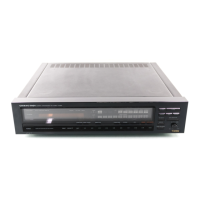
Do you have a question about the Onkyo T-9090 II and is the answer not in the manual?
| Tuning Bands | FM, MW |
|---|---|
| Tuning Scale | Analog |
| FM Tuning Range | 87.5 - 108 MHz |
| Signal to Noise Ratio (MW) | 50 dB |
| Total Harmonic Distortion (FM, mono) | 0.05% |
| Capture Ratio (FM) | 1.0 dB |
| Selectivity (FM) | 80 dB |
| IF Rejection (FM) | 100 dB |
| Stereo Separation (FM, 1 kHz) | 50 dB |
| Type | Stereo Tuner |
| AM Tuning Range | 530 - 1620 kHz |
| Sensitivity (FM) | 1.0 µV |
| Sensitivity (MW) | 300 μV/m |
| Signal to Noise Ratio (FM) | 80 dB |
| Distortion (FM) | 0.05% |
| Frequency Response (FM) | 20 Hz to 15 kHz |
| Output (FM) | 1.0 V |
Reduces harmful speaker vibration interference electrically.
Automatically sets reception modes for best FM broadcast quality.
Provides complete command over tuner functions via remote.
Highlights use of high-quality parts for durability and performance.
Record serial and model numbers for warranty.
Instructions for cleaning the unit's panels and cabinet.
Important warnings before initial power-on, including voltage selection.
Guide to connecting T-shaped and external FM antennas.
Instructions for connecting a 75/300 ohm adapter to coaxial cable.
Din-type antenna input and audio output jacks.
Jacks for connecting an oscilloscope to check multipath issues.
Guide for replacing batteries in the remote control transmitter.
Tips for proper remote control operation and potential interference.
Controls power and indicates unit status.
Shift button for memory banks, preset buttons, and scan.
Tuning mode button, selector buttons, and level adjustments.
Shows signal strength, tuning status, and reception modes.
Buttons for storing stations and APR settings in memory.
Buttons for Muting, APR, Antenna, Mode, IF Bandwidth, RF Mode, Hi-Blend.
Buttons for timer programming and output level adjustment.
Step-by-step guide for tuning FM stations manually.
How to use automatic tuning to find stations.
Automatically recalls stored preset stations for listening.
Storing FM stations and APR settings into memory.
Automatically stores strong stations into memory.
Using terminals to check and adjust for multipath reception.
Explains various indicators for APR, tuning, and muting status.
Details information shown on the main display, including signal strength and frequency.
Location of remote sensor and function of timer indicator.
Buttons for controlling APR modes and preset stations via remote.
Remote buttons for output level, muting, and scan functions.
Step-by-step guide to storing stations and APR settings in memory.
Important notes regarding memory transfer and preservation.
Lists common problems like crackling noise, distortion, and no station recall.
Addresses problems with the remote controller not functioning.
Details tuning range, usable sensitivity, and quieting sensitivity.
Lists capture ratio, rejection ratios, S/N, selectivity, and distortion.
Includes power supply, dimensions, and weight.